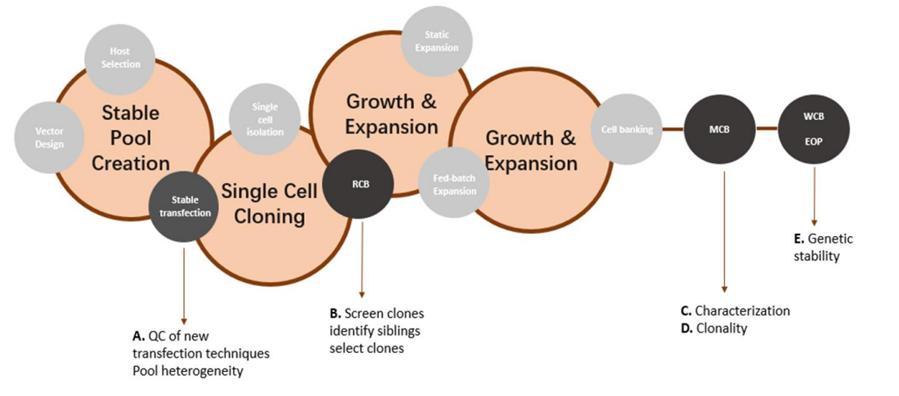BHK-21 Cell Line Transgene Integrations QC & Copy Number (Locus Amplification & Sequencing)
BHK-21 cells are accepted continuous cell line by the regulatory authorities for the manufacture of viral vaccines. Given this inherent genetic flux, recombinant transgenes expressed in BHK-21 cells used for therapeutic bioproduct development can be subjected to genetic alteration that may potentially impact the integrity and stability of those transgenes and, in turn, impact drug substance production. Thus, characterization of the integrity and stability of the integrated transgenes is fundamental in the Vero cell line development.
BHK-21 Cell Line Transgene Integrations QC & Copy Number (Locus Amplification & Sequencing) analysis from Creative Bioarray combines the next generation sequencing to selectively amplify and sequence the transgene and surrounding genomic region. This method not only uncovers insertion sites and sequences of integrated transgenes, but also enables detection of single nucleotide variations, structural variations, and transgene-transgene fusions.
According to ICH Q5B and Q5D guidelines, regulating agencies request that cell substrates must be analyzed at two time points (i.e., on the level of the Master Cell Bank and on the level of the End of Production cells) to show their genetic stability. Typical assays include those intended to confirm the integrity of the product transcript, the genome structure at integration site, and the ratio of insert gene copy number.
BHK-21 Cell Line Transgene Integrations QC & Copy Number (Locus Amplification & Sequencing) analysis can:
- Identify the transgene integration site(s)
- Detect structural changes in the host DNA at the transgene integration site(s)
- Sequence the entire transgene and detect any sequence variants as well as structural changes within the transgene
- Provide an estimation of the transgene copy number
 Figure 1. Overview of different stages of cell line development (in circles).
Figure 1. Overview of different stages of cell line development (in circles).
The BHK-21 Cell Line Transgene Integrations QC & Copy Number (Locus Amplification & Sequencing) Features:
- Genetic stability analysis across various generations (e.g., MCB, WCB, EOP)
- In accordance with ICH Q5B and Q5D guidelines
- Final conclusions on stability of analyzed cell bank(s)
- Reporting meeting regulatory requirements
- Pre-finalization report review included
- Fast turnaround time
Quotation and ordering
Our customer service representatives are available 24hr a day! We thank you for considering Creative Bioarray as your BHK-21 Cell Line Transgene Integrations QC & Copy Number (Locus Amplification & Sequencing) Service partner.
References
- ICH Q5B, Quality of Biotechnological Products: Analysis of the Expression Construct in Cells used for Production of R-DNA Derived Protein Products, Step 4 version (1995).
- Wurm, Florian M., and Maria João Wurm. "Cloning of CHO cells, productivity and genetic stability—a discussion." Processes 5.2 (2017): 20.
- Plavsic, Mark. "Q5D derivation and characterization of cell substrates used for production of biotechnological/biological products." ICH Quality Guidelines (2017): 375-393.
- Galbraith, Daniel. "ICH Q5A: Viral Safety of Biotechnology Products." ICH Quality Guidelines: An Implementation Guide (2017): 311-335.
- Krebs, Lara E., et al. "Effective and efficient characterization of Chinese hamster ovary production cell lines using automated intracellular staining and statistical modeling." Biotechnology Progress 34.3 (2018): 570-583.
- Welch, J. (2017). Tilting at clones: A regulatory perspective on the importance of "Clonality" of mammalian cell banks. CDER/OPQ/OBP/DBRRIV April 24, 2017.
- Paul Wu, et al. "Tools and methods for providing assurance of clonality for legacy cell lines" in "Cell Culture Engineering XVI", A. Robinson, PhD, Tulane University R. Venkat, PhD, MedImmune E. Schaefer, ScD, J&J Janssen Eds, ECI Symposium Series, (2018).
- Frye, Christopher, et al. "Industry view on the relative importance of "clonality" of biopharmaceutical-producing cell lines." Biologicals 44.2 (2016): 117-122.
All products and services on this website are only suitable for non-medical purposes.


 Figure 1. Overview of different stages of cell line development (in circles).
Figure 1. Overview of different stages of cell line development (in circles).


